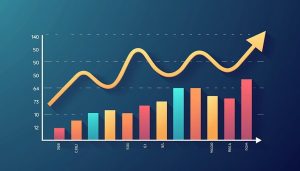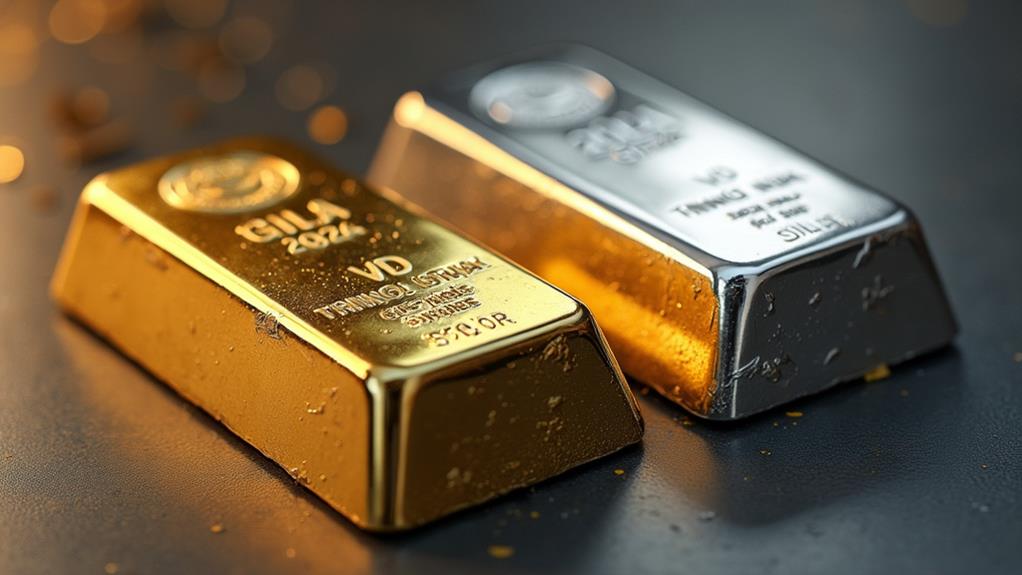When deciding between gold and silver in 2024, consider each metal’s stability, market behavior, and economic hedging benefits. Gold offers steady growth, lower volatility, and stronger returns, making it a reliable long-term investment. Silver, while more affordable at $32 per ounce, faces greater price swings due to industrial demand and inflation-sensitive markets. Gold’s value, at $2,422 per ounce, has surged by 89% over 15 years and consistently outperforms silver. Diversifying with both metals can hedge against economic uncertainty, but gold’s historical performance makes it a safer choice. By exploring further, you’ll uncover detailed insights to inform your decision.
Price Comparison

When comparing gold and silver prices in 2024, it’s clear that gold, priced at $2,422 per ounce, far surpasses silver’s $32 per ounce. This significant price gap highlights the importance of understanding the gold-silver ratio, which currently stands at approximately 76:1. Such a ratio can guide your investment decisions by illustrating the relative value between these two precious metals.
Gold’s higher price isn’t just a number; it signifies its stability and lower price volatility compared to silver. As an investor seeking control, you should note that gold’s price appreciation over the past 15 years has outperformed silver. This historical trend suggests that gold is a more reliable store of value.
However, don’t overlook silver’s advantages. With a lower price of silver, it’s more accessible for those looking to enter the precious metals market. While silver may exhibit higher price volatility, it also offers the potential for substantial gains, especially during periods of economic uncertainty.
Understanding the price comparison between gold and silver enables you to make informed decisions. By recognizing the strengths and weaknesses of each metal, you can tailor your investment strategy to align with your financial goals and risk tolerance.
Historical Performance
When you look at historical performance, gold has consistently outshone silver with stronger returns and less volatility. Over the past 15 years, gold’s value has surged, offering an 89% increase from a $5,000 investment in 2010, while silver barely moved.
Gold’s stability and long-term compounded annual return of 4.87% since 1925 make it a solid choice for preserving wealth, unlike silver, which suffers from inflation and industrial demand fluctuations.
Long-Term Value Trends

Diving into the long-term value trends, you’ll notice gold has consistently outperformed silver, boasting an average annual return of 4.87% since 1925 compared to silver’s 3.46%. This historical performance highlights gold’s superior value retention over extended periods. For those who crave control over their investments, gold’s consistent performance provides a sense of stability and predictability.
Gold’s long-term value retention isn’t just a fluke; it’s backed by decades of historical data.
Silver, on the other hand, often sees its returns influenced by inflation uncertainties and fluctuations in industrial demand. While both metals serve as hedges against inflation and economic turmoil, gold’s track record shows it as a more reliable choice for long-term investment.
If you’re looking to secure your assets against future economic uncertainties, gold’s consistent performance makes it a solid bet. Silver can still play a role in your portfolio, especially given its industrial demand, but it doesn’t offer the same level of long-term value retention. Understanding these long-term value trends helps you make informed decisions, giving you greater control over your financial future.
Volatility and Returns

In examining historical performance, gold’s lower volatility sets it apart from silver, making it a more stable investment. When you’re looking to preserve wealth and guarantee steady returns, gold clearly stands out.
Over the past 15 years, gold has consistently outperformed silver in both returns and price appreciation. Investing $5,000 in gold back in 2010 would have resulted in an 89% increase by 2024. In contrast, the same investment in silver over the same period would only yield a 1% increase.
These historical trends highlight gold’s role as a reliable wealth-preserving tool. Its consistent performance over time provides a sense of control and predictability that silver lacks due to its higher volatility. You can depend on gold to maintain its value better during economic fluctuations, offering stronger returns and a more stable investment option.
When evaluating gold and silver, consider their volatility and returns. Gold’s lower volatility means fewer surprises and more confidence in your investment decisions. As you aim to maximize your wealth preservation strategy, gold’s historical performance proves it to be the superior choice for stability and price appreciation.
Market Volatility

When considering market volatility, you’ll notice that gold historically offers more price stability compared to silver. This stability is partly due to gold’s consistent performance over the past 15 years and its resilience to economic fluctuations.
On the other hand, silver’s industrial demand and smaller market size contribute to its greater price swings, making it a more volatile investment.
Historical Price Stability

Gold’s historical price stability has made it a preferred choice for conservative investors. When you look at gold prices, you’ll notice they exhibit less volatility compared to silver prices. Historical trends show that economic conditions and market trends play a significant role in this stability. For instance, during economic downturns, gold often acts as a safer investment, maintaining its value better than silver.
Silver prices, on the other hand, are more volatile. This volatility arises mainly due to silver’s industrial demand and the smaller market size. While silver can offer higher returns during economic booms, its price swings can be nerve-wracking if you’re looking for stability.
Over the past 15 years, gold has outperformed silver in terms of price stability, making it a more reliable choice during uncertain times.
Understanding how economic conditions impact both metals is essential for making an informed decision. With gold’s consistent performance, you can exercise more control over your investment, especially if you’re risk-averse. Silver, with its greater price fluctuations, might appeal if you’re willing to take on more risk for potentially higher returns. Choose wisely based on your tolerance for market volatility.
Economic Impact Factors

Although gold historically shows less fluctuation, market instability remains an important factor influencing the prices of both gold and silver. You need to understand how economic uncertainties and geopolitical risks can spike market instability, directly impacting gold and silver prices. Gold is often seen as a safe haven, offering stability amid market changes. However, silver, with its strong ties to industrial demand and supply dynamics, experiences more price fluctuations.
When economic uncertainties arise, both metals can see increased demand, but silver’s price can be more unpredictable. Geopolitical risks also add layers of unpredictability, making it essential to factor these elements into your investment decisions. While gold might provide a steadier ride, silver’s higher instability could offer greater potential returns if timed correctly.
Consider how these factors align with your risk tolerance and investment goals. If you’re seeking stability, gold’s lower market instability might be more appealing. On the other hand, if you’re comfortable navigating price changes, silver’s responsiveness to industrial demand and supply dynamics could present lucrative opportunities.
Always weigh the economic impact factors before deciding where to allocate your resources in 2024.
Industrial Demand
Silver’s extensive industrial applications in electronics, solar panels, and smartphones are driving up its demand significantly. As you assess the silver market, you’ll notice that its industrial demand profoundly influences its market value. Silver’s diverse industrial applications mean it’s a key component in numerous sectors, making it essential.
However, you should be aware that silver demand fluctuations can occur due to changes in industrial production. For example, when industrial activity ramps up, silver demand typically increases, boosting its price. Conversely, any slowdown in production can lead to reduced demand and impact silver price dynamics. Monitoring these trends is vital if you want to make informed decisions about your investments.
Despite a noted decrease in silver demand for jewelry, industrial sectors continue to sustain silver’s relevance and market performance. The World Silver Survey highlights this shift, emphasizing the steady rise in demand for silver in high-tech and green energy applications.
Understanding these factors allows you to anticipate how industrial demand will affect your silver investments. By keeping an eye on silver industrial sectors and their production levels, you can better navigate the market and make strategic choices that align with your financial goals.
Inflation Hedge

When inflation spikes, gold’s historical stability makes it a preferred hedge, while silver’s industrial demand also helps maintain its value.
You might find it beneficial to diversify with both precious metals to buffer against economic uncertainties.
Considering their unique strengths, gold and silver can both play a critical role in your inflation protection strategy.
Gold’s Inflation Hedge Stability
In times of economic uncertainty and rising prices, gold stands out as a dependable hedge against inflation. When inflation erodes the purchasing power of fiat currencies, investors flock to gold as a secure haven asset. Its historical performance shows that gold maintains its value during high inflation periods, making it a robust option for value preservation.
Gold’s scarcity and intrinsic value contribute to its effectiveness as an inflation hedge. Unlike paper money, which can be printed at will, the limited supply of gold guarantees its stability. This makes gold a trustworthy choice for wealth preservation during economic uncertainties.
You’ve likely noticed that gold’s value tends to rise during inflationary periods, providing a buffer against the loss of purchasing power.
If you’re looking to protect your assets, gold’s proven track record as an inflation hedge can’t be overlooked. It’s not just about preserving wealth—it’s about maintaining control over your financial future amid high inflation. With gold, you get a stable asset that can weather the storm of economic upheavals, allowing you to safeguard your investments effectively.
Silver’s Industrial Demand Appeal
Unlike gold, which is primarily valued for its scarcity and historical role as a store of value, silver stands out due to its significant industrial demand. Silver’s unique appeal lies in its extensive use in electronic applications, from solar panels to smartphones. This industrial demand not only boosts silver’s value but also positions it as a versatile commodity.
When considering a silver investment, you should know that its industrial applications make it an effective inflation hedge. During growth periods, silver demand spikes, reflecting the broader economic expansion‘s influence on its price. According to the World Silver Survey, while silver demand for jewelry might’ve dipped, its use in industrial and electrical applications has surged, highlighting its dynamic nature.
Investing in silver isn’t just about owning a precious metal; it’s about leveraging a commodity that thrives on technological advancements and economic growth. This dual role of silver – both as an industrial workhorse and a hedge against inflation – makes it a compelling option for those seeking to broaden their investment portfolio. By capitalizing on silver’s industrial demand, you tap into a resource that offers both stability and growth potential.
Diversifying With Precious Metals

Amid economic uncertainties and rising inflation, diversifying with precious metals like gold and silver stands out as a strategic move. Investing in precious metals isn’t just about owning shiny objects; it’s a calculated approach to protect your wealth. Gold and silver serve as reliable hedges against inflation, ensuring long-term wealth preservation.
Gold has a longstanding reputation as a store of value during turbulent times and inflationary periods. It’s not just about holding an asset; it’s about securing your financial future.
Silver, on the other hand, brings an additional layer of security with its industrial demand, driving up value and providing robust portfolio diversification.
Consider these benefits:
- Inflation Hedge: Both metals offer protection against rising prices, maintaining purchasing power.
- Store of Value: Historically, gold has preserved value even when currencies falter.
- Industrial Demand: Silver’s use in technology and industry can boost its market value.
- Currency Devaluation Protection: Precious metals can safeguard your assets against the decline in currency value.
Investment Strategies
When considering investment strategies for gold and silver in 2024, diversification is key. To gain control over your investments, you should weigh the benefits of various options. Start by looking at gold and silver ETFs like iShares Gold Trust (IAU). ETFs offer a straightforward way to add precious metals to your portfolio without the hassle of physical storage.
If you prefer tangible assets, purchasing physical gold bars or silver coins gives you direct ownership. This can be a strong choice if you’re concerned about financial stability and want something you can hold in your hand.
Another route is investing in gold or silver mutual funds, which provide exposure to the precious metals industry while spreading risk across multiple assets. This can be a solid strategy if you’re aiming for portfolio diversification.
Don’t overlook companies in the precious metals industry. Investing in mining stocks or related businesses can offer significant returns, but it comes with different risks compared to owning the metals directly.
Ultimately, your choice between gold and silver will depend on your long-term financial goals. Both options have their merits, so assess them carefully to find the best fit for your investment strategy.
Economic Downturns
Economic downturns often prompt investors to seek safe havens, and that’s where gold and silver shine. When the economy takes a hit, these precious metals can help you hedge against inflation and retain value. Gold and silver play pivotal roles in wealth protection and providing stability in portfolios during challenging times.
Gold’s scarcity makes it a reliable asset. Its limited supply guarantees that it remains valuable, offering profitability even when other investments falter. Gold acts as a safe haven, providing a cushion against economic volatility.
Silver, on the other hand, has unique advantages due to its industrial uses. Its demand in sectors like solar energy can drive up prices, especially during economic downturns when alternative energy sources gain attention. Silver’s industrial demand can present significant growth potential.
For effective portfolio preparation, incorporating both gold and silver can give you the upper hand:
- Gold’s scarcity secures long-term value
- Silver’s industrial demand offers growth opportunities
- Both metals act as a hedge against inflation
- They provide stability in portfolios during economic depressions
Expert Opinions
According to various expert opinions, investing in gold and silver comes with its share of debate. Warren Buffett, for instance, advises against investing in gold or silver, favoring long-term stock market investments instead. He believes that stocks offer better returns over time compared to precious metals.
However, gold vs silver advocates argue that these metals can serve as a hedge against market volatility and inflation.
Forbes Advisor suggests that those considering investing in gold or silver should seek professional financial advice. This guarantees you get personalized recommendations tailored to your unique financial situation and market conditions. It’s essential to regularly review performance information to make informed decisions.
When purchasing gold or silver, consider the reputation, fees, and security measures of the vendors. Not all vendors offer the same level of reliability and security. Thus, thorough evaluation is vital to maintain control over your investments.
In the end, the choice between investing in gold or silver depends on your financial goals and risk tolerance. While expert opinions vary, equipping yourself with thorough research and personalized financial advice ensures you’re making the best possible choice for your long-term investment strategy.
Long-Term Viability
While expert opinions vary on the best approach to investing in gold or silver, one key factor to ponder is their long-term viability. Historically, gold has outperformed silver, especially over the last 15 years. If you’d invested $5,000 in gold in 2010, you’d see an impressive 89% increase by 2024, compared to a mere 1% increase for silver. This trend underscores gold’s reputation as a wealth-preserving tool, making it a reliable choice for long-term investment strategies.
Precious metals like gold and silver act as hedges against economic uncertainties, ensuring their enduring value in your portfolios. Historical trends show that both metals have retained their value over the long term. This resilience adds layers of security and reliability to your investment decisions.
Consider the following points:
- Gold’s historical performance: Outperformed silver with an 89% increase over 15 years.
- Wealth-preserving nature: Gold is widely viewed as a reliable store of value.
- Economic uncertainties: Both metals serve as effective hedges.
- Long-term trends: Historical data supports their viability.
Buying Options
When considering your options for investing in gold or silver, you’ll find several avenues to explore, each with its own set of advantages. If you prefer direct ownership, you can purchase physical gold bars or silver coins. This gives you tangible assets that you control, providing a sense of security and stability.
For those inclined towards market investments, consider ETFs that track gold and silver prices, such as iShares Gold Trust (IAU) and iShares Silver Trust (SLV). These ETFs offer a convenient way to buy gold or silver without the need to store physical metals.
Additionally, investing in mutual funds or companies within the precious metals industry can expose your portfolio to the broader market trends and potential growth of this sector.
Diversified investments are vital for stability, especially during market fluctuations. When weighing gold vs silver, think about your financial goals, available capital, and how these metals fit within your existing portfolio. Whether you choose to purchase physical assets or invest in market-tracking funds, having a well-rounded approach will help you navigate the complexities of the precious metals industry.
Frequently Asked Questions
Should I Buy Gold or Silver in 2024?
You should buy gold if you want stability and less volatility. If you’re aiming for higher returns and can handle more risk, go for silver. Consider your investment goals and market trends to make the best choice.
What to Know Before Buying Silver and Gold?
Before buying silver and gold, consider gold’s stability and historical performance. Silver’s industrial use could drive demand, but it’s more volatile. Evaluate your risk tolerance and investment goals to make an informed decision. Control your financial future.
Is Gold a Good Investment for 2024?
You should consider gold for 2024 if you value stability and a hedge against inflation. Despite Warren Buffett’s advice, gold’s current price reflects its reliability in uncertain times, offering a secure way to diversify your portfolio.
Is It Better to Invest in Silver or Gold?
You should consider gold if you want stability and wealth preservation during economic downturns. On the other hand, silver could appeal to you if you’re seeking a hedge against inflation and benefiting from its industrial uses.
Conclusion
In 2024, your choice between gold and silver hinges on your investment goals. Gold’s stability makes it a solid hedge against inflation, while silver’s industrial demand might offer higher returns. Both metals have pros and cons, so consider historical performance and market volatility. Listen to expert opinions and think about long-term viability. Whether you’re looking for a safe haven or growth potential, weigh your options carefully to make an informed decision.

